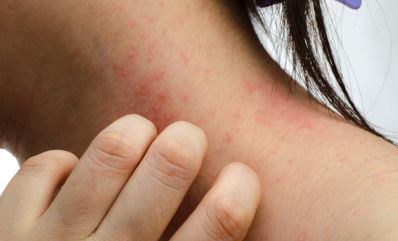
Published: December 4, 2023
Contact dermatitis is defined as any skin disorder caused by contact with a substance that elicits an allergic or irritant response.
Examples of allergic contact dermatitis include rashes developing hours to days after contact with the following:
- metals (such as nickel or gold containing jewelry)
- cosmetics or personal care products (due to fragrances, sunscreens or preservatives)
- latex materials or rubbers
- adhesives
- plants (such as poison ivy)
- topical medicated creams (such as Neosporin)
Examples of irritant contact dermatitis include localized rashes developing minutes to hours after contact with the following:
- strong chemicals
- detergents
- solvents
- acid
- physical irritants such as fiberglass, wood or metal tools
What are symptoms of contact dermatitis?
Allergic contact dermatitis:
- Symptoms typically start hours to days after exposure to a contact allergen.
- Patients typically feel intense itching but may also experiencing burning or stinging
- The rash is usually localized with common affected areas including hands, scalp, eyelids, face, neck, arms, underarms and groin.
- The rash may have redness, swelling, vesicles (small fluid filled blisters) or larger blisters.
- In rare cases, the rash may be more diffuse.
Irritant dermatitis:
- Symptoms typically start minutes to hours after exposure to an irritant.
- Patients typically experience burning, stinging or pain.
- The rash is usually localized in the area of exposure. The rash may appear just red in mild cases but may have significant redness, swelling, oozing, and blistering in severe cases.
Who is at risk of developing contact dermatitis?
- The incidence of allergic contact dermatitis seems to increase with age due to repetitive contact and prolonged exposure to common sensitizers/allergens.
- Allergic contact dermatitis affecting the face, neck or scalp is slightly more common in women than men due to use of cosmetics containing fragrances and sunscreens, jewelry worn on the neck or ears containing nickel, and hair dyes.
- Some research studies have shown allergic contact dermatitis is more common in patients with eczema.
- Those at highest risk for irritant dermatitis include food handlers, healthcare workers, mechanical industry workers, hairstylists, cleaners and housekeepers.
How do you diagnose contact dermatitis?
- A careful history is important to isolate any possible factors involved prior to the onset of the rash including changes in personal care products, detergents, soaps, jewelry, workplace exposures or outdoor exposures.
- Patch testing is used to diagnose allergic contact dermatitis. It involves placement of patches containing individual contact allergens on the patient’s back for 48 hours. The results are then evaluated at the 48-hour and 72-hour time marks from initial placement.
How is contact dermatitis treated?
- The mainstay of treatment is identification and strict avoidance of the offending allergens or irritants.
- Once a rash has developed, topical steroids or topical calcineurin inhibitors can help treat the inflammation associated with contact dermatitis.
- In severe cases, oral steroids such as prednisone may be necessary.
- In cases of irritant dermatitis or chemical exposures, identification of the offending agent using materials safety data sheets is also important.
If you have questions about contact dermatitis please call our office or schedule an appointment online.